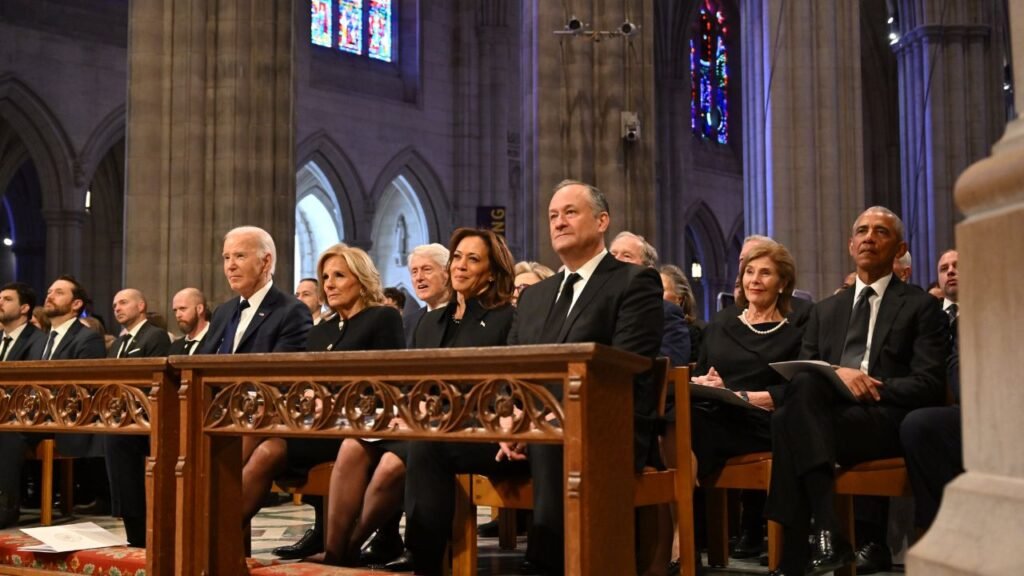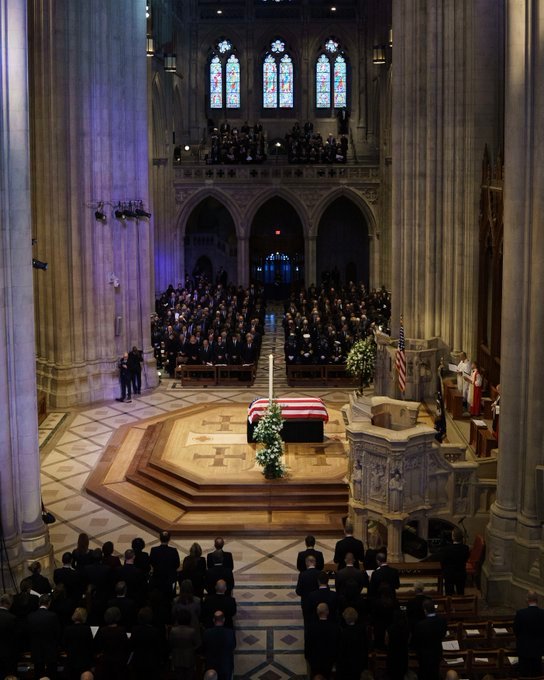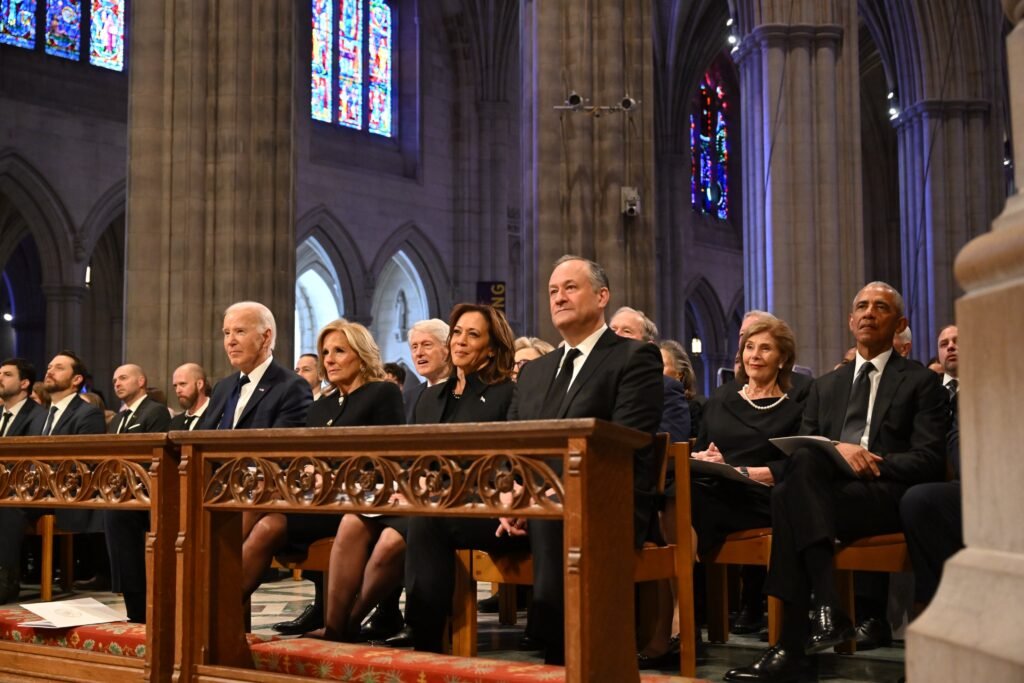Unity In Mourning: A Rare Moment In American History
- Leave a Comment
- James M
- January 10, 2025

Five American presidents, including Bill Clinton, George W. Bush, Barack Obama, Donald Trump, and Joe Biden, gathered in Washington National Cathedral to honor Jimmy Carter, the 39th president of the United States, in a unique and historic event.
It was Carter’s state funeral, a time that emphasized the solemn unity of the nation’s highest position and cut across partisan lines. These five men stood side to shoulder, a living timeline of leadership spanning wars, crises, and transformative eras, and together they have changed decades of American history.
The event emphasized the profound importance of the US presidency, an office that combines enormous authority with the burden of public accountability. It was made clear at Carter’s funeral that the presidency is more than just a position; it is a representation of tenacity and continuity.
In this instance, these leaders were people upholding a common dedication to democracy and service rather than enemies or political rivals. Their presence acted as a reminder of the timeless principles that, despite disagreements, unite the country.
The occasion was given significant significance by Jimmy Carter’s humanitarian and presidential legacies. Carter, who was well-known for his moral rectitude, humility, and commitment to human rights, changed the definition of service in his post-White House life.
He proved that leadership is not limited to a tenure in office by implementing programs like Habitat for Humanity and international peacebuilding projects. Those who gathered to celebrate him found great resonance in his dedication to service, which demonstrated the enduring worth of kindness and tenacity.
More than just a historical anecdote, the attendance of five presidents at Carter’s funeral reflects the humanity of the office. These leaders are people who experience the pleasures and responsibilities of their positions, regardless of their political personas and policy choices.
Their mutual respect and sorrow during this somber time serve as a potent reminder that leadership is primarily about serving the people.

An Illustration of Humanity and Power
A powerful representation of both humanity and authority can be found in the picture of the five US presidents together during Jimmy Carter’s state funeral. Bill Clinton, George W. Bush, Barack Obama, Donald Trump, and Joe Biden stood side by side in the solemn Washington National Cathedral, symbolizing the entire range of American leadership from 1993 to the present.
A visual representation of the continuity and development of the American presidency is produced by this uncommon meeting of former and current presidents. Despite the political differences that frequently characterize their tenures, the image of these men, each of whom was a product of their time, coming together to celebrate Carter spoke loudly about the office’s enduring relevance.
These five men collectively have 379 years of life experience. This extensive collective history reflects the times they served as presidents as well as their individual experiences. They all served as leaders at pivotal periods in American history, including wars, economic upheaval, civil rights movements, and worldwide changes.
Their years of service together, despite their differing political views, form a living record of leadership and show the lengthy history of American government. The weight of history and choices that will continue to reverberate for future generations is captured in the 379 years.
The significance of this assembly is found in what each president has left behind as well as in what they stand for as a group. Despite coming from various times and holding different views, Clinton, Bush, Obama, Trump, and Biden’s attendance at the funeral represented the greater unity of the president itself.
At Carter’s funeral, respect for a fellow leader whose life exemplified humility and public service overshadowed ideological differences. Diverse viewpoints but a shared goal encapsulated the spirit of American democracy in this moment.
This event served as a reminder of the larger scope of American history rather than only a snapshot in time. The American presidency has always represented both authority and responsibility, from George Washington, who established the office, to Abraham Lincoln, whose leadership kept the Union intact, to Franklin D. Roosevelt, whose New Deal transformed the country.
The picture of these five men standing together in awe of Jimmy Carter links them to this historical heritage and demonstrates how the presidency continues to play a crucial role in determining the course of the country regardless of time, party, or political affiliation.
Trump and Obama conversing at Jimmy Carter’s funeral. Remember folks the oligarchy is one big club and you aren’t in it! pic.twitter.com/wQrl33E5MU
— Power to the People ☭🕊 (@ProudSocialist) January 9, 2025
The Presidency's Magnificence and Ordinance
A paradox, the American presidency strikes a balance between grandeur and empathy. The ceremonial “Hail to the Chief” that is played whenever a president enters a room and the potent presence of the presidential seal that adorns speeches, documents, and official events are only two examples of the grandiose rituals, symbols, and traditions that surround the office.
These emblems demonstrate the enormous authority and power bestowed onto the person holding the position. From this perspective, the president is a mythical character who symbolizes not only the nation but also its values. The humanity of the person who has to make tough choices, live under continual scrutiny, and carry the burden of history, however, is hidden beneath this façade of authority.
In addition to highlighting the unique nature of the position, the presidential rituals and symbols are intended to evoke awe and respect. These external manifestations of the office’s significance range from the inauguration procession to the grandeur of state funerals. But the opulence frequently conceals the difficulties that each president faces on a personal level.
Although the public is frequently unaware of the emotional toll that leadership takes, events such as Jimmy Carter’s state funeral serve as a reminder that these leaders are also people who go through periods of loss, sadness, and introspection. Even if these public ceremonies are breathtaking, they highlight the weight that presidents bear as both human beings and leaders.
The obvious cost of each of these five presidents’ terms was apparent as they came together to pay tribute to Carter. They had all been impacted by time. Clinton, Bush, Obama, Trump, and Biden’s aging faces demonstrated the psychological and physical toll of being a country’s leader by reflecting years of personal and professional struggles.
Their lives had been molded by the weight of choices—some well-received, some contentious—in ways that made them more sympathetic and real. Their mutual sorrow and admiration for Carter at that precise moment served as more evidence that being a leader has a significant personal cost. The fact that the presidency is essentially a human undertaking, despite its majesty and authority, was highlighted by this scene.
Carter’s funeral provided a unique opportunity to see the human aspect of the administration. Despite the grandeur of the event, the five men present were bound together by their humanity rather than their political accomplishments. As they honored a fellow leader, their expressions were filled with grief and introspection.
In this instance, the public personas of these presidents—typically depicted as aloof and untouchable—were replaced by displays of respect and grief. The nation was reminded that the president is primarily about serving others and the very personal moments that characterize leadership when it saw these influential people, each of whom was considering the end of Carter’s life and legacy.
LOTS OF MATERIAL SO FAR AT JIMMY CARTER'S FUNERAL:
— Breaking911 (@Breaking911) January 9, 2025
- Trump shakes hands with Mike Pence.
- Obama does not shake Trump or Melania's hand - but shakes everyone else's hands.
- Bush walks right past the Trump's, then slaps Obama in the stomach and shakes hands with everyone else.
-… pic.twitter.com/Nx5vZ77Hqb
Jimmy Carter left behind a legacy of modest, unwavering service that is unquestionably significant but frequently disregarded in favor of more spectacular presidencies. According to his lifelong friend and advisor Stuart Eizenstat, Carter is deeply rooted in the “foothills” of American presidential history, even though he may not be a “Mount Rushmore” figure.
Carter’s commitment to human rights, public service, and ethical leadership won him widespread respect across the political spectrum, despite the fact that his presidency was not distinguished by significant international conflicts or broad legislative successes. This esteem was only strengthened by his post-presidential career, which demonstrated that his dedication to service extended beyond his tenure in the White House.
Since Carter spent a large portion of his life working for humanitarian causes, his post-presidential career became a potent example of public service. His work with Habitat for Humanity, where he assisted in the construction of homes for the underprivileged worldwide, is among his most well-known accomplishments. His unwavering support of international peace, human rights, and conflict resolution solidified his reputation as a president whose deeds had an impact long after he left office. Carter’s dedication to service demonstrated that a leader’s beliefs, which they maintain long after leaving office, characterize their leadership, not the position itself. His example provides guidance on how to lead with honesty and compassion.
Even though Carter’s presidency was characterized by relative calm and low-key government, those who attended his funeral left a lasting imprint. The political landscape of the United States has been permanently altered by Clinton, Bush, Obama, Trump, and Biden. Generations of citizens were impacted by their presidencies, which also changed domestic policies and international affairs. Their combined influence on history carries a tremendous weight. Their tenure has influenced civil rights, economic policies, and wars, and their effects will be discussed for years to come. Together, they stood in remembrance of Carter, symbolizing the variety of struggles and victories they had encountered while serving as president.
History was also shaped by the five presidents who came together to pay tribute to Carter at his funeral. The magnitude of their duties unites them, despite the fact that each had a distinct journey and encountered particular difficulties.
Their choices continue to reverberate across American history, from Clinton’s involvement in the Balkan Wars to Obama’s management of the Great Recession and Trump’s impact on world politics.
Like Carter’s, their respective presidencies will be contested for years to come, but there is no denying their combined influence on the nation and the wider world. The weight of leadership and the long-lasting effects of presidential actions are demonstrated by their tenure at the head of the country.

The presidency’s timeless symbolism serves as a potent reminder of the principles that underpin the US. Even while the position is frequently linked to authority, status, and power, it also represents service to the public. During Jimmy Carter’s funeral, this symbolism was evident.
Five presidents from various political eras and ideologies came together to underscore the changing nature of the office while reinforcing its fundamental mission: to serve and represent the American people. Despite its enormous power, the presidency is nevertheless a post that is subject to the American democratic system and answerable to the people who choose its representative.
“Government of the people, by the people, for the people,” which Lincoln famously stated in his Gettysburg Address, reverberated throughout Carter’s funeral. Regardless of their political differences, the appearance of five presidents together represented the continuance of this idea.
Together with Carter’s family and friends, they all joined together in a time of sadness to celebrate the life of a leader who, like them, was ultimately obligated to serve the people. It was a potent reminder that, at its foundation, being president is about carrying out the duty that the people have given to you, not about pursuing personal goals.
Like all presidents, the leaders in attendance at the funeral are ultimately answerable to the people and to history, despite their enormous power. No matter their status or power, presidents are still people who have to live with the consequences of their choices. This is illustrated by the picture of these individuals in sorrow, considering Jimmy Carter’s life.
They are not perfect individuals who are impervious to the effects of time or the opinions of subsequent generations. The five presidents’ attendance at Carter’s ceremony served as more evidence that leadership is a shared duty, with both successes and setbacks woven into the annals of history.
The former president’s grandson, Jason Carter, gave a moving eulogy that touched on the idea of the “power of regular people.” That leadership ultimately originates from and is answerable to the people is what this phrase best captures about the American democratic system. Despite the responsibility that comes with the job, presidents are still a part of a broader system of government that was established by and for the people.
Jason’s remarks served as a reminder to everyone in attendance that the principles of democracy—government of, by, and for the people—remain essential to the presidency’s legacy. This instance demonstrated the conviction that the will of the American people as a whole, not any one person, ultimately controls the government.
Five American presidents came together for Jimmy Carter’s state funeral, providing a unique moment of cohesion and continuity during a highly divided political environment. The sight of five men—Clinton, Bush, Obama, Trump, and Biden—standing together, unified in honoring a former president, provided a potent visual reminder of the wider continuity of American leadership in a world where partisan beliefs are dividing people more and more.
Despite their disagreements, these politicians united to honor Carter, proving that the president is still a unifying institution even in a divided political environment. This instance of solidarity served as a reminder that, at its foundation, leadership is not limited by political affiliations and that, even in the most difficult circumstances, people can be united by common values.
History will unavoidably evaluate the leaders in attendance as it observes the circumstances surrounding Carter’s funeral. Each of the five presidents present has had an impact on the nation, and time will reveal the full extent of their contributions.
Future generations will closely examine their choices in times of crisis, how they handled wars and economic downturns, and how they influenced international policy. The greater historical narrative will include this contrast between Carter’s legacy as a modest, compassionate leader and some of the more controversial times his successors went through.
The principles of democracy never go out of style, even as leaders’ personalities and actions may. The gathering of these leaders at Carter’s funeral brought to light a fundamental reality: the principles that the people in the White House are supposed to defend, not the people themselves, are what make American democracy strong. The event served as a tribute to the timeless values of accountability, service, and humility that characterize the president’s job.
The principles of liberty, fairness, and democratic governance will continue to direct the country regardless of how different the next generation of leaders may be. This moment was a reminder that the core of American democracy is unwavering, even in the face of changing administrations.
In addition to reflecting on the past, the attendees at Carter’s funeral also learned important lessons for the future. It served as a reminder that ultimately, leadership is about serving the people and the country’s values rather than pursuing power for its own purpose.
Each of these five presidents symbolized a distinct period of American history, and their images demonstrated the tenacity of the democratic system that unites the country. This moment of solidarity in a divided globe serves as a reminder that, despite possible changes in the political landscape, the United States will continue to be guided by the timeless principles of democracy.
Conclusion:
The fact that five US presidents attended Jimmy Carter’s funeral served as a potent reminder of the historical and human aspects of leadership. The weight of their combined experiences was evident in that one, moving moment, not only in their shared humanity but also in their roles as political leaders.
In the end, these guys are just people—individuals who have carried the burden of administration and whose deeds have influenced the trajectory of American history—regardless of the grandeur of the office they occupied. Their presence in that solemn setting, honoring a fellow president, served as a reminder that being a leader is both a gift and a burden, filled with both success and failure.
As a meeting of leaders from the past and present, Carter’s burial also represented the resilience of American democracy. The solidarity shown at this gathering underscored the persistence of democratic values that cut across all governments and individuals during a period of severe political divide.
While presidents may have diverse political backgrounds and opinions, the ceremony reminded that they are all obligated to serve and maintain democratic values under the same constitutional oath. It served as a reminder that the will of the people who create and uphold American democracy is just as strong as its institutions.
When we consider the function of presidents, we see them as both servants of the people and symbols of power. The post of president entails a great deal of responsibility, and those who hold it do so knowing that they are answerable to both history and the general public.
This dedication to service was reflected in Carter’s life as president and humanitarian, and the celebration of his life showed the close bond between the office and the people it is supposed to represent.
In the end, presidents serve as both representations of the nation’s values and the people entrusted with achieving them, serving as a reminder that genuine leadership is determined by one’s devotion to others rather than one’s position.
